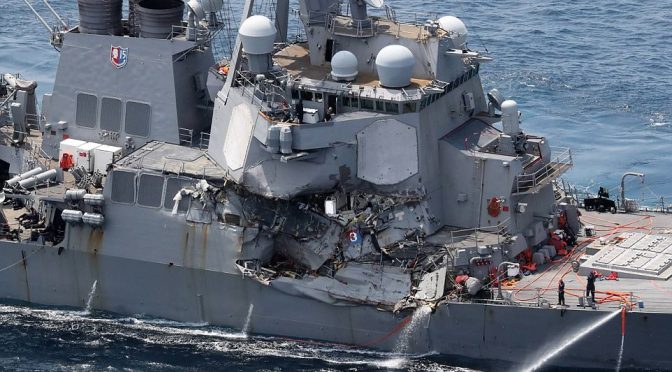Editor’s Note: This piece by three professors from the US Naval War College is comprehensive and disturbing. Very much worth the read for anyone remotely interested in maritime or cybersecurity issues.
Our thanks to Mr. Richard Hiscock and the folks at Maritime-Executive.com for calling attention to it.

WHY ARE OUR SHIPS CRASHING? COMPETENCE, OVERLOAD, AND CYBER CONSIDERATIONS
These are exclusively the personal views of the authors and do not necessarily reflect the views of the U.S. Naval War College or the Department of Defense.
Security researchers do not believe in coincidences. In the past few weeks, a very rare event – a U.S. Navy destroyer colliding fatally with a huge commercial vessel – happened twice in a short period of time. These incidents followed a collision involving a cruiser off Korea and the grounding of a minesweeper off the Philippines, and have now resulted in the relief of a senior Seventh Fleet admiral. Surface warfare officers (SWOs) look to weather, sensors, watchstanders, training requirements, leadership and regulations (COLREGS) as possible contributing factors to the collisions.
Cyber security scholars, in contrast, first look to the underlying complex technologies trusted by the crew to determine the proper course of action. With the advancements in navigational technology, computer-aided decision making and digital connectivity, it is human nature that seafarers become more dependent on, as well as electronic aids for navigation and trusting the data the systems provide. While the U.S. Navy emphasizes verification of this data by visual and traditional navigation means, the reality is the social acceptance of the validity of electronic data is a feature of modern culture. The U.S. Navy, with an average age in the early 20s for sea-going sailors, is not immune from this effect. But what if the data is invalid or, as an extreme possibility, subject to outside manipulation?
In directing a pause for all warship crews (not currently conducting vital missions) during which to conduct assessments and additional training, the Chief of Naval Operations – Admiral John Richardson – was asked whether the Navy was considering cyber intrusion as a possible cause. The CNO responded that concerning cyberattack or intrusion, “the review will consider all possibilities.”
The truth could be that only mundane factors contributed to the accident, but as an intellectual thought experiment, what follows are explanations following the logic of open-source information. The first set of explanations will focus on the human in the loop to argue that the fundamental cause is likely human miscalculation rather than intentional distortion of data. The second explanation will focus on the criticality of accurate data provided to humans or their technologies. The pattern suggests a lack of ‘normalness’ as the ‘normal accidents’ of complex systems deeply integrated with cyber technologies – in frequency, locations, and effects. In the case of the destroyers, a credible case—based on analysis of land-based systems–could be made for a witting or unwitting insider introduction of malicious software into critical military navigation and steering systems. The conclusion will offer motivations for timing and targets, and some recommendations for the future.

